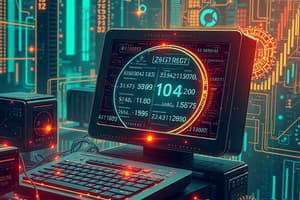Podcast
Questions and Answers
What was the primary function of individuals originally referred to as 'computers'?
What was the primary function of individuals originally referred to as 'computers'?
- To design computer hardware
- To write programming languages
- To perform repetitive calculations (correct)
- To maintain computer networks
Which of the following statements correctly describes Napier's invention of logarithms?
Which of the following statements correctly describes Napier's invention of logarithms?
- They allow division to be performed via multiplication.
- They were first presented in a visual format using colored diagrams.
- They enable multiplication to be performed via addition. (correct)
- They were based on the concept of binary numbers.
Which device was invented by Blaise Pascal at the age of 19?
Which device was invented by Blaise Pascal at the age of 19?
- Pascaline (correct)
- Stepped reckoner
- Slide rule
- Abacus
Who built the first known four-function calculator and advocated for the binary number system?
Who built the first known four-function calculator and advocated for the binary number system?
What was the primary limitation of the Pascaline created by Blaise Pascal?
What was the primary limitation of the Pascaline created by Blaise Pascal?
What was the primary function of the Difference Engine proposed by Charles Babbage?
What was the primary function of the Difference Engine proposed by Charles Babbage?
Which two components make up the main parts of Babbage's Analytic Engine?
Which two components make up the main parts of Babbage's Analytic Engine?
What significant development followed the use of punched cards by Herman Hollerith?
What significant development followed the use of punched cards by Herman Hollerith?
Which of the following best describes the Mark I's construction?
Which of the following best describes the Mark I's construction?
What was the main purpose of the ENIAC I developed by Mauchly and Eckert?
What was the main purpose of the ENIAC I developed by Mauchly and Eckert?
Flashcards are hidden until you start studying
Study Notes
Early Definitions and Tools
- "Computer" originally referred to individuals performing complex calculations, largely women, for tasks like navigational tables and astronomical data.
- The abacus, dating back to 300 B.C. with origins in Babylon, served as one of the earliest tools for mathematical calculations, enhancing human memory during processes.
- Skilled abacus users can perform additions quickly, but multiplication and division take longer.
Historical Innovations
- John Napier invented logarithms in 1617, allowing multiplication through addition, leading to the creation of Napier's Bones, which were ivory sticks with logarithm values.
- The slide rule emerged in 1632 in England and was used until the 1960s, notably by NASA engineers for space missions.
- Blaise Pascal created the Pascaline in 1642, a gear-driven calculator capable of only addition to assist his tax collector father, but it struggled with accuracy and high costs.
Advancements in Calculating Devices
- Gottfried Wilhelm Leibnitz developed the stepped reckoner, the first four-function calculator, and advocated for the binary number system.
- Joseph Marie Jacquard introduced punched cards in 1801, which automated weaving patterns, paving the way for computational methods.
- Charles Babbage conceptualized the Difference Engine in 1822 to compute logarithm tables and further developed the more advanced Analytic Engine, which had a programmable nature.
Pioneering Mechanical Computers
- Herman Hollerith adopted punched cards for data computation, founding the company that evolved into IBM. His machines counted data and utilized visual indicators for results.
- The Mark I, developed in partnership with Harvard and IBM in 1944, was the first programmable digital computer in the U.S., made from mechanical components and weighing 5 tons.
Birth of Electronic Computers
- ENIAC I, developed in 1946 by John Mauchly and John Presper Eckert, was the first electronic computer, required 17,468 vacuum tubes, weighed 30 tons, and performed calculations significantly faster than predecessors.
- First-generation computers (1946-1958) used vacuum tubes, which were large and unreliable. This generation included the UNIVAC series.
Transition to Transistors
- The second generation (1959-1964) replaced vacuum tubes with transistors, vastly improving speed, reliability, and reducing size and cost, as one transistor could replace up to 40 vacuum tubes.
- Transistors, primarily made from silicon, became ubiquitous in computer manufacturing.
Era of Integrated Circuits
- The third generation (1965-1970) introduced integrated circuits (ICs), which combined multiple transistors onto a single silicon chip, enhancing efficiency and performance.
Modern Computing
- The fourth generation (1971-Present) saw the rise of microprocessors, which serve as the brains of computers. Most computers now utilize several processors with a focus on the Central Processing Unit (CPU).
Computer Types and Classifications
- Analog computers use continuous variables for complex calculations and are becoming rare.
- Hybrid computers combine analog and digital functions, with digital components converting analog signals for processing.
- Mainframe computers serve large organizations, performing vast computations and supporting simultaneous users.
- Microcomputers, commonly known as PCs, include desktops, laptops, tablets, and smart devices used by individuals.
- Minicomputers support fewer users than mainframes but are still vital in businesses for accounting and operations.
- Supercomputers are the most powerful type, used for extensive calculations in research, capable of processing trillions of operations per second.
Components of a Computer System
- Input devices (e.g., keyboard, mouse) facilitate data entry.
- Output devices (e.g., monitor, printer) display results.
- The control unit coordinates data flow between the CPU and peripherals.
Studying That Suits You
Use AI to generate personalized quizzes and flashcards to suit your learning preferences.



